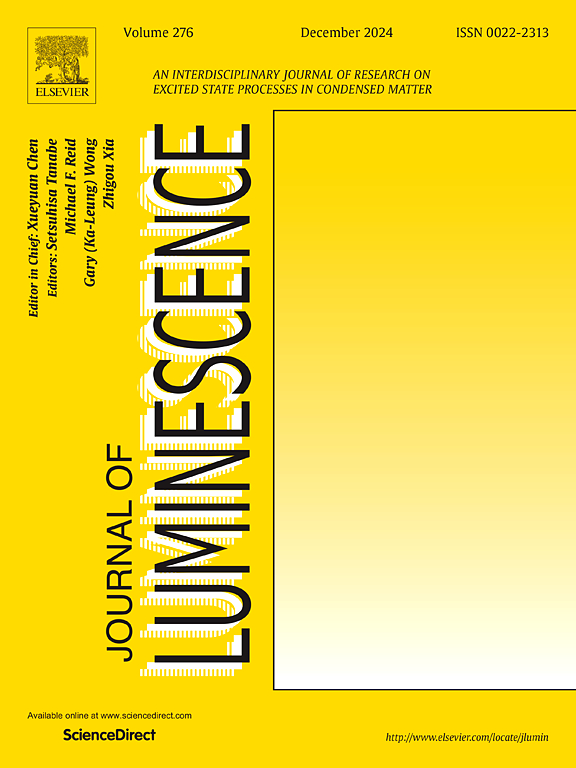Visible and infrared up-conversion emission in Er3+-doped fluorochlorozirconate glasses under 1550 nm and 980 nm excitations
IF 3.3
3区 物理与天体物理
Q2 OPTICS
引用次数: 0
Abstract
Upconversion (UC) and photoluminescence (PL) measurements were carried out on trivalent erbium (Er3+) doped fluorochlorozirconate (FCZ) glasses. The experiments show that neither PL spectra nor PL relaxation times depend on Er3+ concentration up to 2 at.%, indicating the absence of clusterization and collective effects. Radiation diffusion was also excluded based on the PL decay lifetime being experimentally the same in powder and bulk samples. Additionally, FCZ:Er3+ shows an efficient up-conversion in visible and IR regions under 1550 nm or 980 nm pumping. The intensity of up-converted PL bands versus pumping intensity (G) behavior follows PL ∝ Gn with n varying from 1 to 3 depending on the PL band and pump wavelength and intensity. The observed dependences and variation of n may be interpreted by a model of linear rate equations for seven lower manifolds, approximated by six monolevels. The validity of this approximation is supported by the application of the McCumber theory to the shapes of PL and optical absorption spectra. The present model for the experimental data was also supplemented by using Judd-Ofelt parameters obtained from the absorption spectra on the same set of glasses. It should be emphasized that the model developed in this work provides a self-consistent interpretation of the upconversion experiments at 1550 and 980 nm pumping reported herein.
Er3+掺杂氟氯锆酸盐玻璃在1550 nm和980 nm激发下的可见光和红外上转换发射
对三价铒(Er3+)掺杂氟氯锆酸盐(FCZ)玻璃进行了上转换(UC)和光致发光(PL)测量。实验表明,在2 at以下的Er3+浓度对PL谱和PL弛豫时间都没有影响。%,表明不存在集群化和集体效应。辐射扩散也被排除在外,因为粉末和散装样品的PL衰变寿命实验相同。此外,在1550 nm或980 nm泵浦下,FCZ:Er3+在可见光和红外区域表现出有效的上转换。上转换PL波段的强度与抽运强度(G)行为遵循PL∝Gn,根据PL波段和抽运波长和强度的不同,n从1到3变化。观察到的依赖关系和n的变化可以用七个较低流形的线性速率方程模型来解释,这些流形近似于六个单水平。将McCumber理论应用于PL的形状和光吸收光谱,证明了这种近似的有效性。利用同一套玻璃上的吸收光谱所得的Judd-Ofelt参数对实验数据的模型进行了补充。应该强调的是,本工作中开发的模型为本文报道的1550和980 nm泵浦的上转换实验提供了自一致的解释。
本文章由计算机程序翻译,如有差异,请以英文原文为准。
求助全文
约1分钟内获得全文
求助全文
来源期刊

Journal of Luminescence
物理-光学
CiteScore
6.70
自引率
13.90%
发文量
850
审稿时长
3.8 months
期刊介绍:
The purpose of the Journal of Luminescence is to provide a means of communication between scientists in different disciplines who share a common interest in the electronic excited states of molecular, ionic and covalent systems, whether crystalline, amorphous, or liquid.
We invite original papers and reviews on such subjects as: exciton and polariton dynamics, dynamics of localized excited states, energy and charge transport in ordered and disordered systems, radiative and non-radiative recombination, relaxation processes, vibronic interactions in electronic excited states, photochemistry in condensed systems, excited state resonance, double resonance, spin dynamics, selective excitation spectroscopy, hole burning, coherent processes in excited states, (e.g. coherent optical transients, photon echoes, transient gratings), multiphoton processes, optical bistability, photochromism, and new techniques for the study of excited states. This list is not intended to be exhaustive. Papers in the traditional areas of optical spectroscopy (absorption, MCD, luminescence, Raman scattering) are welcome. Papers on applications (phosphors, scintillators, electro- and cathodo-luminescence, radiography, bioimaging, solar energy, energy conversion, etc.) are also welcome if they present results of scientific, rather than only technological interest. However, papers containing purely theoretical results, not related to phenomena in the excited states, as well as papers using luminescence spectroscopy to perform routine analytical chemistry or biochemistry procedures, are outside the scope of the journal. Some exceptions will be possible at the discretion of the editors.
 求助内容:
求助内容: 应助结果提醒方式:
应助结果提醒方式:


